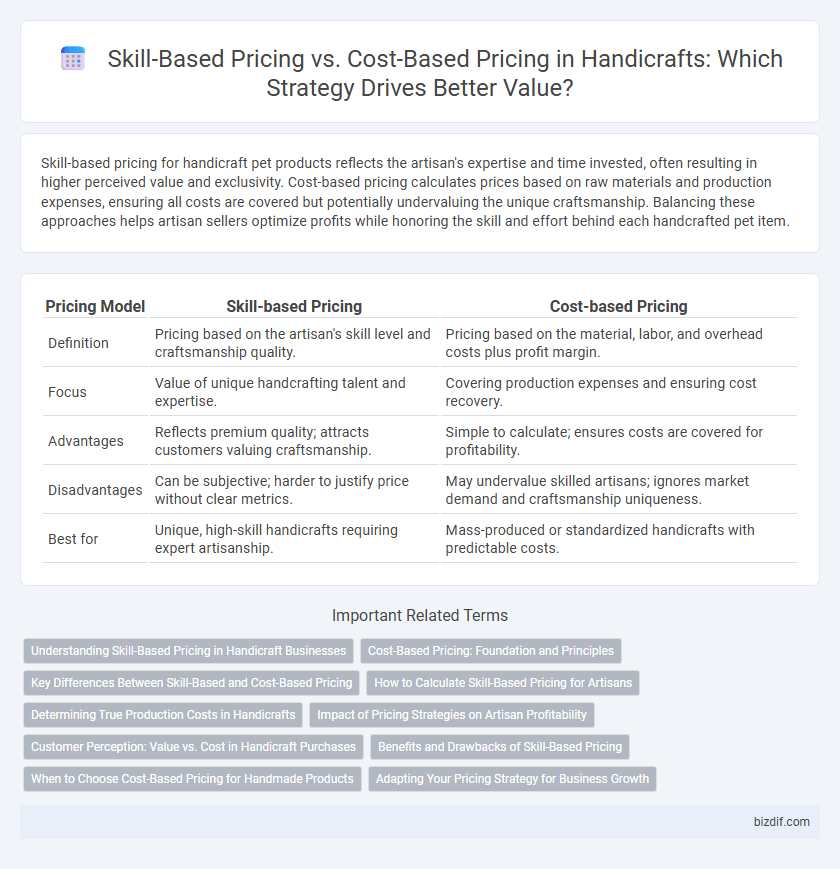Skill-based pricing for handicraft pet products reflects the artisan's expertise and time invested, often resulting in higher perceived value and exclusivity. Cost-based pricing calculates prices based on raw materials and production expenses, ensuring all costs are covered but potentially undervaluing the unique craftsmanship. Balancing these approaches helps artisan sellers optimize profits while honoring the skill and effort behind each handcrafted pet item.
Table of Comparison
| Pricing Model | Skill-based Pricing | Cost-based Pricing |
|---|---|---|
| Definition | Pricing based on the artisan's skill level and craftsmanship quality. | Pricing based on the material, labor, and overhead costs plus profit margin. |
| Focus | Value of unique handcrafting talent and expertise. | Covering production expenses and ensuring cost recovery. |
| Advantages | Reflects premium quality; attracts customers valuing craftsmanship. | Simple to calculate; ensures costs are covered for profitability. |
| Disadvantages | Can be subjective; harder to justify price without clear metrics. | May undervalue skilled artisans; ignores market demand and craftsmanship uniqueness. |
| Best for | Unique, high-skill handicrafts requiring expert artisanship. | Mass-produced or standardized handicrafts with predictable costs. |
Understanding Skill-Based Pricing in Handicraft Businesses
Skill-based pricing in handicraft businesses assigns value based on the artisan's expertise, creativity, and time invested, reflecting the unique craftsmanship behind each product. This approach often results in higher prices compared to cost-based pricing, which calculates prices solely on materials and production expenses. Understanding skill-based pricing helps artisans capture fair compensation for their specialized abilities and artistic value, enhancing profitability and brand differentiation.
Cost-Based Pricing: Foundation and Principles
Cost-based pricing in handicraft business involves calculating the total production cost, including raw materials, labor, and overhead, then adding a markup for profit. This method ensures all expenses are covered and provides a clear pricing structure based on tangible costs. It offers artisans a reliable foundation for pricing, helping maintain profitability and financial sustainability.
Key Differences Between Skill-Based and Cost-Based Pricing
Skill-based pricing in handicraft centers on the artisan's expertise, time, and craftsmanship, reflecting the unique value and rarity of handmade products, whereas cost-based pricing calculates the price based on materials, labor costs, and overhead expenses. Skill-based pricing often results in higher profit margins due to the perceived exclusivity and superior quality of skilled handiwork, while cost-based pricing ensures coverage of production costs and a consistent pricing structure. The key difference lies in value perception: skill-based pricing highlights the artisan's talent and market demand, while cost-based pricing emphasizes the tangible inputs used in the creation process.
How to Calculate Skill-Based Pricing for Artisans
Skill-based pricing for artisans is calculated by assessing the complexity, time investment, and expertise required for each handicraft piece, often factoring in an hourly rate based on skill level. Artisans analyze their proficiency and market demand, then multiply the effective hours spent on crafting by a rate that reflects their craftsmanship and uniqueness. This method ensures pricing aligns with the artisan's specialized skills rather than mere material or production costs.
Determining True Production Costs in Handicrafts
Determining true production costs in handicrafts involves accurately assessing both material expenses and the extensive labor required for skill-based pricing, which reflects the artisan's expertise and craftsmanship. Cost-based pricing, in contrast, primarily accounts for raw materials and overhead, often undervaluing the unique skill contribution. Properly balancing these factors ensures pricing that covers production costs while fairly compensating the artisan's specialized skills.
Impact of Pricing Strategies on Artisan Profitability
Skill-based pricing enables artisans to capture the true value of their craftsmanship by reflecting the complexity and expertise involved in creating unique handicrafts, often resulting in higher profit margins. Cost-based pricing focuses on covering production expenses and adding a markup, which may limit profitability if market prices do not align with these calculated costs. Adopting skill-based pricing empowers artisans to differentiate their products in competitive markets, enhancing revenue potential and long-term sustainability.
Customer Perception: Value vs. Cost in Handicraft Purchases
Skill-based pricing in handicraft emphasizes the artisan's expertise, craftsmanship, and unique creative input, leading customers to perceive greater intrinsic value and authenticity in the product. Cost-based pricing focuses on materials and production expenses, which may limit customer perception to the item's monetary cost rather than its artistic worth. Handicraft buyers often prioritize skill-driven value, willing to pay premium prices when the artisan's craftsmanship is clearly communicated and appreciated.
Benefits and Drawbacks of Skill-Based Pricing
Skill-based pricing in handicraft allows artisans to set prices that reflect their expertise, craftsmanship quality, and unique artistic techniques, often resulting in higher profit margins and perceived value. This method encourages skill development and rewards mastery but may alienate price-sensitive customers and complicate standard pricing models. However, it can lead to inconsistent pricing, making it challenging to predict profits and manage customer expectations effectively.
When to Choose Cost-Based Pricing for Handmade Products
Cost-based pricing for handmade products is ideal when production costs are consistent and easily quantifiable, ensuring every material and labor expense is covered. This method suits artisans targeting steady profit margins without frequent market fluctuations, especially in niche handicraft markets with limited price sensitivity. Selecting cost-based pricing helps maintain financial stability during large batch productions or when introducing new handcrafted product lines with established cost structures.
Adapting Your Pricing Strategy for Business Growth
Skill-based pricing leverages the unique craftsmanship and expertise inherent in handicraft products, allowing artisans to set higher prices that reflect their specialized skills and intricate labor. Cost-based pricing, focusing on material expenses and production time, ensures a minimum profit margin but may undervalue the artisan's creativity and brand reputation. Adapting your pricing strategy by blending skill-based and cost-based methods can drive sustainable business growth, positioning your handicraft products competitively while maximizing revenue.
Skill-based Pricing vs Cost-based Pricing Infographic

 bizdif.com
bizdif.com